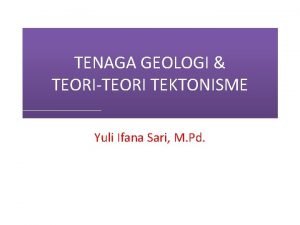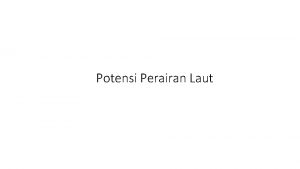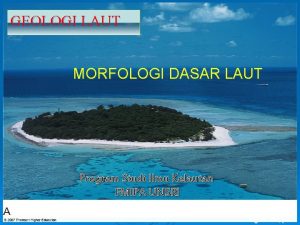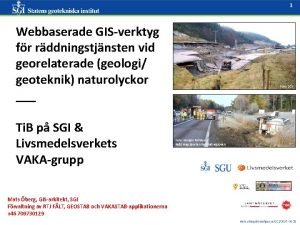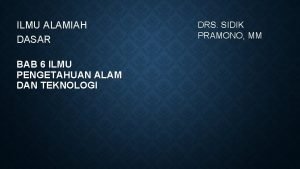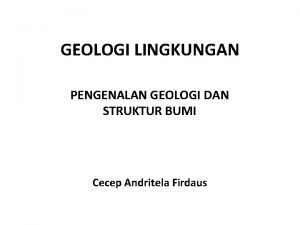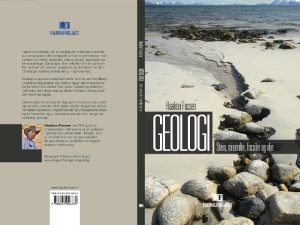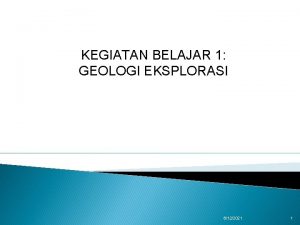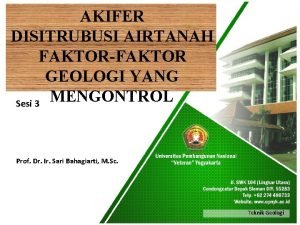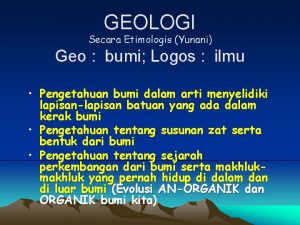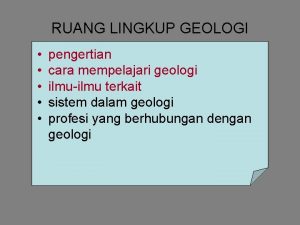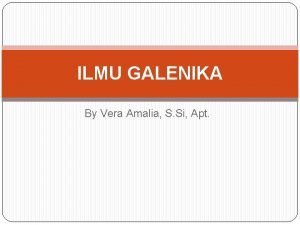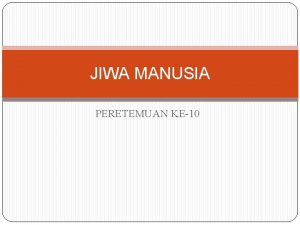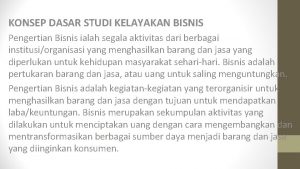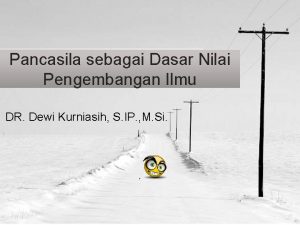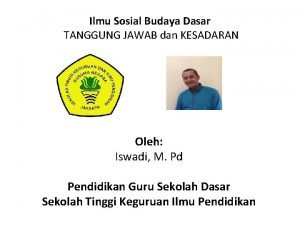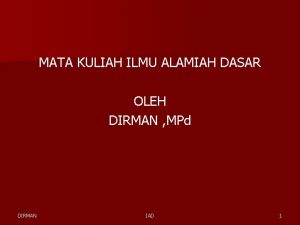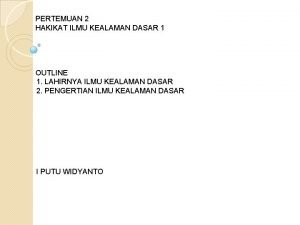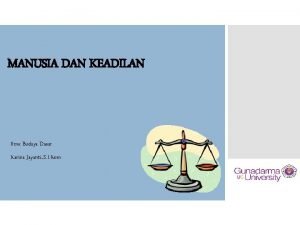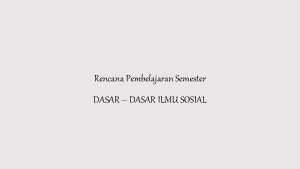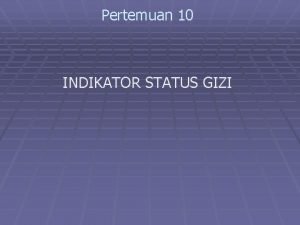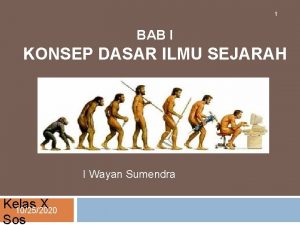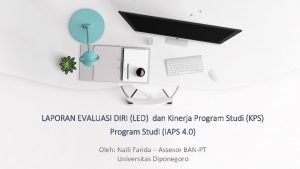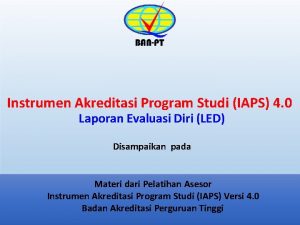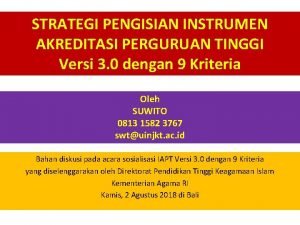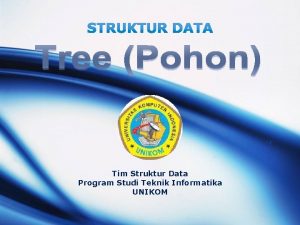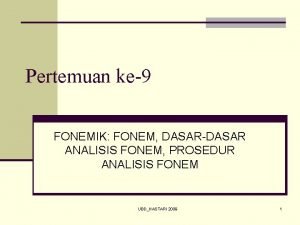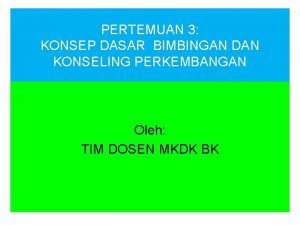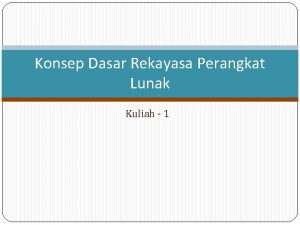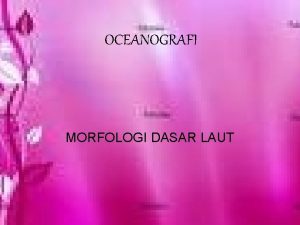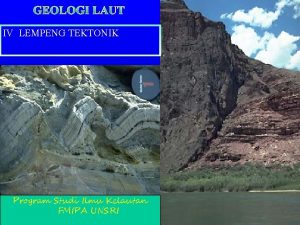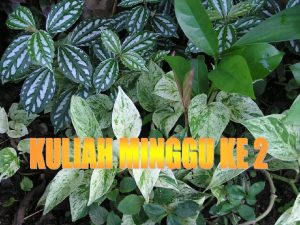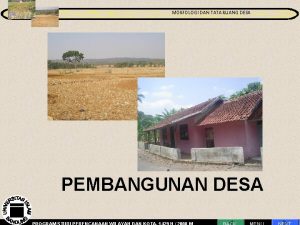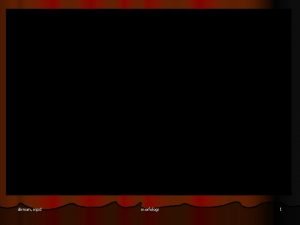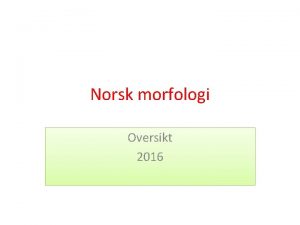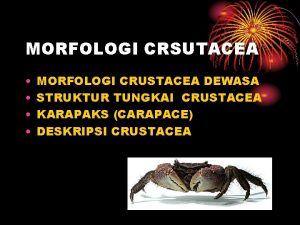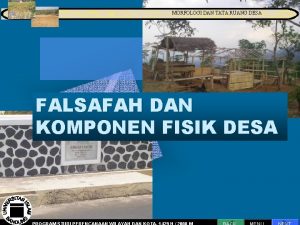GEOLOGI LAUT MORFOLOGI DASAR LAUT Program Studi Ilmu















































- Slides: 47

GEOLOGI LAUT MORFOLOGI DASAR LAUT Program Studi Ilmu Kelautan FMIPA UNSRI Fig. 16. 38 a, p. 423

Topograpi dasar laut? ? Bentuk 2, pola dan konfigurasi fisik permukaan dasar laut. Kenampakan dasar laut: Kombinasi aktivitas tektonik dan the processes of erosion and deposition.

Dasar Laut Oceans = 71% of the Earth’s surface. Belahan bumi utara: 60% laut, 40% daratan Belahan bumi selatan: 83% laut, 17% daratan. v. Four main ocean basins: v Pacific, v Atlantic, v Indian, and v Arctic Laut Pacific Laut paling luas dan paling dalam (average depth ~4, 000 meters)

Ocean Basins Arctic Ocean

Bathymetry: Peta dasar laut : Ø Echo sounding Ø Multibeam Systems Ø Satellite Altimetry

Sound beam emitted by echo sounder (beam angle is exaggerated) Seafloor True depth immediately beneath vessel Measured depth equals true depth Echo sounding : Measured depth is less than actual depth Fig. 4 -2 a, p. 79

Echo-sounding: menggambarkan topografi dasar laut

Multibeam Systems: Kombinasi banyak echo sounder Multibeam systems : dpt memberikan hasil pengukuran yg lebih akurat. Menggunakan 121 beams radiating from a ship’s hull. Beam ini dapat mengkover sudut 120°

Satellites: Dpt digunakan untuk pemetaan kontur dasar laut Menggunakan satellite altimetry, sea surface levels dapat diukur lebih akurat,

Topografi dasar laut bervariasi menurut lokasi Cross sections Atlantic Ocean basin dan the continental United States, menunjukkan range elevasi. Skala vertical exaggeration: 100: 1. Although ocean depth is clearly greater than the average height of the continent, the general range of contours is similar.

Struktur Dasar Laut Continental Margin : Continental Shelf (near continent) Continental Slope Continental Rise Submarine Canyons 1. Continental Margins – Bagian sisi benua yang terdapat di bawah permukaan laut • Passive margins, disebut Atlantic-type margins, face the edges of diverging tectonic plates. Sangat sedikit/no aktivitas volcanic atau gempabumi yg terdapat pada daerah ini. • Active margins, known as Pacific-type margins, terletak dekat sisi converging plates. Active margins tempat aktivitas vulkanik atau gempa bumi.

2. Deep Ocean Basin : Abyssal Plains Oceanic ridges 3. Lain 2: a Trenches b Seamounts and Guyots c Atolls


Continental slope Continental Shelf Volcanic island Seamount Continental rise Continental shelf Continental slope Abyssal plain mid-ocean ridge Rift valley trench

Kenampakan Utama

Kenampakan Dasar Laut Flat-topped seamounts eroded by wave action are called guyots. Abyssal hills are small, extinct volcanoes or rock intrusions near the oceanic ridges. 16

Continental Margins Passive • • Active Passive continental margins mempunyai continental shelf, continental slope, and continental rise descending to the abyssal plain Active continental margins have continental shelves and slopes, but the slope extends down into a deep oceanic trench A mid-oceanic ridge system encircles the globe, typically running down the center of oceans Banyak gunung laut yang berbentuk kerucut rise from the deep ocean floor

Continental margin Deep-ocean basin Submarine canyon profile (cut through continental shelf) Sediment Continental shelf Continental slope Oceanic ridge Continental rise Sediment Continental crust (granitic) Oceanic crust (basaltic) Asthenosphere Oceanic crust (basaltic) 18

An active margin Peru–Chile Plate Trench boundary Narrow continental shelf Pacific Ocean Nazca Plate movement A passive margin Andes Plate boundary Mountains Broad South America continental shelf Atlantic Ocean South American Deep basin Plate movement Subduction zone (deep and shallow earthquakes) African Plate movement Mid-Atlantic Ridge (spreading centers, shallow earthquakes) • Atlantic = Passive Margin little/no geologic activity • Pacific = Active Margin geologic activity 19

passive margin NO plate boundary at edge of continent • shelf and slope • continental rise (less steep than slope) • abyssal plain (smooth, deep seafloor)

Continental shelf: perluasan dari continent dan berhubungan dengan dataran pantai, Ø Kemiringan 0, 1 derajat Ø Lebar beberapa km – 50 km, kedalaman 100 – 200 m Ø Umumnya Sedimen terakumulasi pada daerah ini ke daerah C. Slope by: Turbidity current Ø Sedimen berasal dari continent Terrigeneous sediemet Ditutupi oleh sedimen muda Ø

most material comes from erosion of continent http: //media. allrefer. com/s 1/l/c 0601400 -continental-shelf. jpg


Continental slope Ø Kemiringan bertambah yg menghubungkan the Continental shelf to abyssal plan. Ø Kemiringan slope 4 – 5 derajat Ø Kedalaman terus bertambah star 100 -200 m to 4. 000 – 6. 000 m

Continental rise Kemiringan semakin berkurang, 0, 5 derajat menghubungkan dasar laut dg continental shelf. Ø Masih dianggap bagian dari continental. Ø Berakhir pd abisal plan pd kedalaman kira 5 km Ø Berada di atas oseanik crust Ø

Abyssal plains Ø Abyssal plains daerah datar yang terdapat di deep ocean basin floor. Ø Kenampakan plg datar di bumi dengan slope < 0, 01 derajat Ø Umumnya terletak antara kaki continental rise dan a mid-oceanic ridge. Ø Kedalaman 4, 000 – 6, 000 m

Abyssal Plains: Deep, flat areas that are composed mostly of sediment. The Atlantic Ocean has the most substantial. Abyssal plains and abyssal hills cover most of Earth’s surface. Abyssal plains • 40% of the ocean floor • common in the Atlantic • rare in the Pacific • covered by sediment Abyssal hills • small sediment-covered extinct volcanos or rock

Abyssal hills Ø Hills (Bukit 2) along the ocean floor. Ø Tinggi dan diameter bervariasi Ø Kebanyakan lebih besar dibanding bukit 2 di darat. Ø 100 -2000 meters high

Seamounts are volcanic projections from the ocean floor that do not rise above sea level. Flat-topped seamounts eroded by wave action are called guyots Abyssal hills are flat areas of sediment-covered ocean floor found between the continental margins and oceanic ridges. Abyssal hills are small, extinct volcanoes or rock intrusions near the oceanic ridges.

Submarine Canyon • Submarine canyons - V-shaped valleys that run across continental shelves and down continental slopes – Deliver continental sediments to abyssal fans on deep sea floor, sometimes by turbidity currents

Submarine Canyons

Submarine Canyons Form at the Junction between Continental Shelf and Continental Slope These are features of some continental margins. They cut into the continental shelf and slope, often terminating on the deepsea floor in a fan-shaped wedge of sediment. 32

Oceanic Trenches • Oceanic trench-> daerah sempit, • Palung dalam, parallel thp sisi/tepi continent atau an island arc – Bagian yang paling dalam dari lautan

Mid-Oceanic Ridges • Mid-oceanic ridge - giant undersea mountain range extending around the world like the seams on a baseball – Made mostly of young basalt flows – More than 80, 000 km long, 1, 500 -2, 500 km wide, and rises 2 -3 km above ocean floor – A rift valley, 1 -2 km deep, runs down the crest of the ridge – Shallow focus earthquakes common – Extremely high heat flow – Often marked by line of hot springs, supporting unique biological communities

Mid-Ocean ridge • A mid-ocean ridge is an underwater mountain range, typically having a valley known as a rift running along its spine (punggung), formed by plate tectonics. It is usually an oceanic spreading center, which is responsible for seafloor spreading.

Coral Reefs • Coral (symbiotic coral + alga) are filter feeders, (at present) only live in fairly warm, clear, agitated waters. • Coral reefs are due to accumulation of the calcareous remains of corals and algae, along with minor contributions from other organisms, like sponges and shellfish. • Reefs come in three main types. First two are found in the geologic record, as well as live. Atolls are not found in the geologic record. –Fringe reefs occur along the margins of land. Only conditions needed by coral are necessary for fringe reefs to form. If sea-level is constant, they propagate seaward, leading to barrier reefs. –Barrier reefs occur offshore from land at the surf zone. As a fringe reef grows, the water above it becomes less agitated, a condition necessary for coral. Coral keeps growing in the surf zone, so the live part of a reef can be separated from the land. Fragmented bits of reef fill in the lagoon (quiet water area behind the reef). (Why would this be different for atolls? ) –Atolls occur in deep water, and are usually circular rims of reef around a central lagoon. They form as fringe or barrier reefs around an island. The central lagoon is due to karst dissolution of the central part of an originally flat island when sea level was lower during the last glaciation. (We know this because a) we don't find ancient atolls and b) when we drilled a lot into Bikini Atoll, the lower part looked like a perfectly normal fringe reef, and the upper bit looked like it had been karsted, and partially filled in)

other sea floor features seamount conical mountain that rises > 1, 000 m above sea floor; basaltic volcanoes; chains of seamounts occur (aseismic ridges) (Emperor seamounts) guyot flat-topped seamount; erosion from waves; reefs common around them

Sea Mount • A seamount is a mountain rising from the ocean seafloor that does not reach to the water's surface (sea level), and thus is not an island. These are typically formed from extinct volcanoes, that rise abruptly.

Volcanic seamounts and guyots project above the seabed • >1 km in height • important seamount fishing areas • about 30, 000 Emperor • about 10, 000 in the Pacific Seamount s http: //upload. wikimedia. org/wikipedia/en/thumb/2/25/Seamount_Locations. png/350 px. Seamount_Locations. png

Guyot • A guyot also known as a tablemount, is a flat-topped seamount. Their flatness is due to erosion by waves, winds, and atmospheric processes.

Guyot: flat-topped seamount that once reached the surface http: //en. wikipedia. org/wiki/Image: Guyot. j pg

Trench • The oceanic trenches are hemispheric-scale (one hemisphere to another) long but narrow topographic depressions of the sea floor. They are also the deepest parts of the ocean floor.

Mariana Trench • Is the deepest part of the world's oceans, and the deepest location on the surface of the Earth's crust. It has a maximum depth of about 10, 911 meters, or 11 kilometers.

Atlantic http: //www. cryingvoice. com/Evolution/gifs/hydro. NA. jpg

Dimana atoll tedapat? Ø Most of the world's atolls are in the Pacific Ocean and Indian Ocean Ø The Atlantic Ocean has no large groups of atolls other than eight atolls east of Nicaragua

Atoll Ø An atoll is an island of coral that encircles a lagoon partially or completely.

Terimakasih
 Morfologi dasar laut
Morfologi dasar laut Morfologi dasar laut
Morfologi dasar laut Morfologi adalah
Morfologi adalah Loihi seamount
Loihi seamount Geologi dasar
Geologi dasar Perbedaan ilmu alamiah dasar dan ilmu pengetahuan alam
Perbedaan ilmu alamiah dasar dan ilmu pengetahuan alam Indikator geologi
Indikator geologi Geologi adalah
Geologi adalah Geologi stein mineraler fossiler og olje
Geologi stein mineraler fossiler og olje Geologi
Geologi Geologi
Geologi Chalkosfer
Chalkosfer Secara etimologis kata geologi
Secara etimologis kata geologi Ruang lingkup geologi
Ruang lingkup geologi Diurusniagakan bina ayat
Diurusniagakan bina ayat Apakah kata majmuk
Apakah kata majmuk Ilmu galenika adalah ilmu yang mempelajari tentang
Ilmu galenika adalah ilmu yang mempelajari tentang Hubungan ilmu politik dengan ilmu sejarah
Hubungan ilmu politik dengan ilmu sejarah Hubungan ilmu farmasi dengan ilmu fisika
Hubungan ilmu farmasi dengan ilmu fisika Hubungan antropologi dengan ilmu lain
Hubungan antropologi dengan ilmu lain Struktur pengetahuan
Struktur pengetahuan Apakah khodam itu musyrik
Apakah khodam itu musyrik Hubungan ilmu akhlak dengan ilmu tasawuf
Hubungan ilmu akhlak dengan ilmu tasawuf Pengertian kelayakan usaha
Pengertian kelayakan usaha Nilai ketuhanan sebagai dasar pengembangan ilmu
Nilai ketuhanan sebagai dasar pengembangan ilmu Kesadaran tanggung jawab sosial
Kesadaran tanggung jawab sosial Materi kuliah ilmu alamiah dasar semester 2
Materi kuliah ilmu alamiah dasar semester 2 Pengertian ilmu kealaman dasar
Pengertian ilmu kealaman dasar Manusia dan keadilan ilmu budaya dasar
Manusia dan keadilan ilmu budaya dasar Konsep ilmu budaya dasar
Konsep ilmu budaya dasar Ilmu sosial dasar gunadarma
Ilmu sosial dasar gunadarma Rps ilmu alamiah dasar
Rps ilmu alamiah dasar Studi gizi ui
Studi gizi ui Pengertian sejarah menurut nugroho notosusanto
Pengertian sejarah menurut nugroho notosusanto Prinsip prinsip dasar ilmu sejarah
Prinsip prinsip dasar ilmu sejarah Dampak positif penggunaan pestisida
Dampak positif penggunaan pestisida Konsep dasar ilmu pendidikan
Konsep dasar ilmu pendidikan Bahasa arab karbohidrat
Bahasa arab karbohidrat Led program studi
Led program studi Contoh rencana evaluasi
Contoh rencana evaluasi Led program studi
Led program studi Borang akreditasi 9 kriteria
Borang akreditasi 9 kriteria Tingkat kejenuhan program studi
Tingkat kejenuhan program studi Program studi unikom
Program studi unikom Prosedur analisis fonem
Prosedur analisis fonem Konsep dasar bimbingan konseling
Konsep dasar bimbingan konseling Dasar rekayasa perangkat lunak
Dasar rekayasa perangkat lunak Pertanyaan tentang surat bisnis
Pertanyaan tentang surat bisnis
